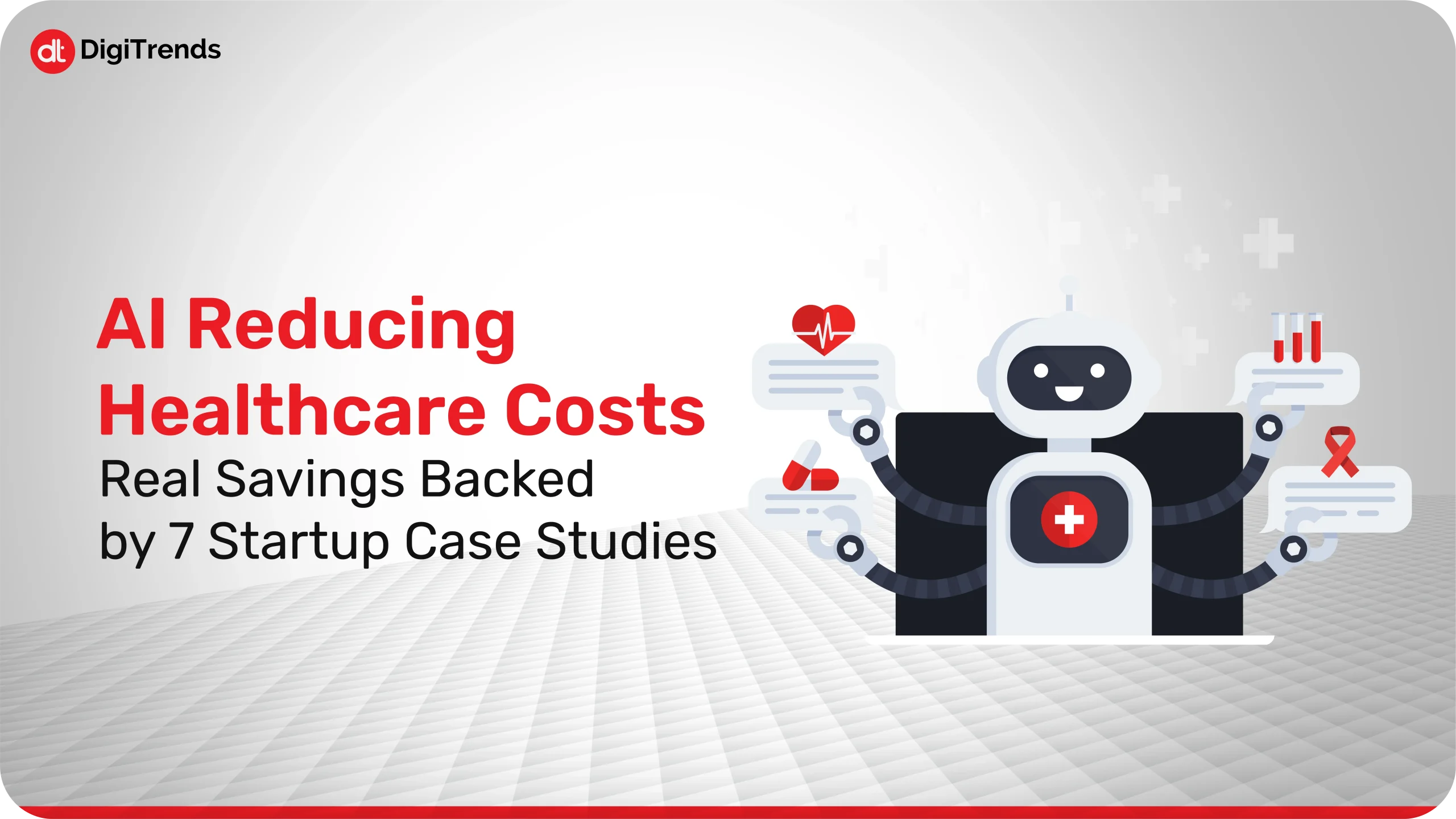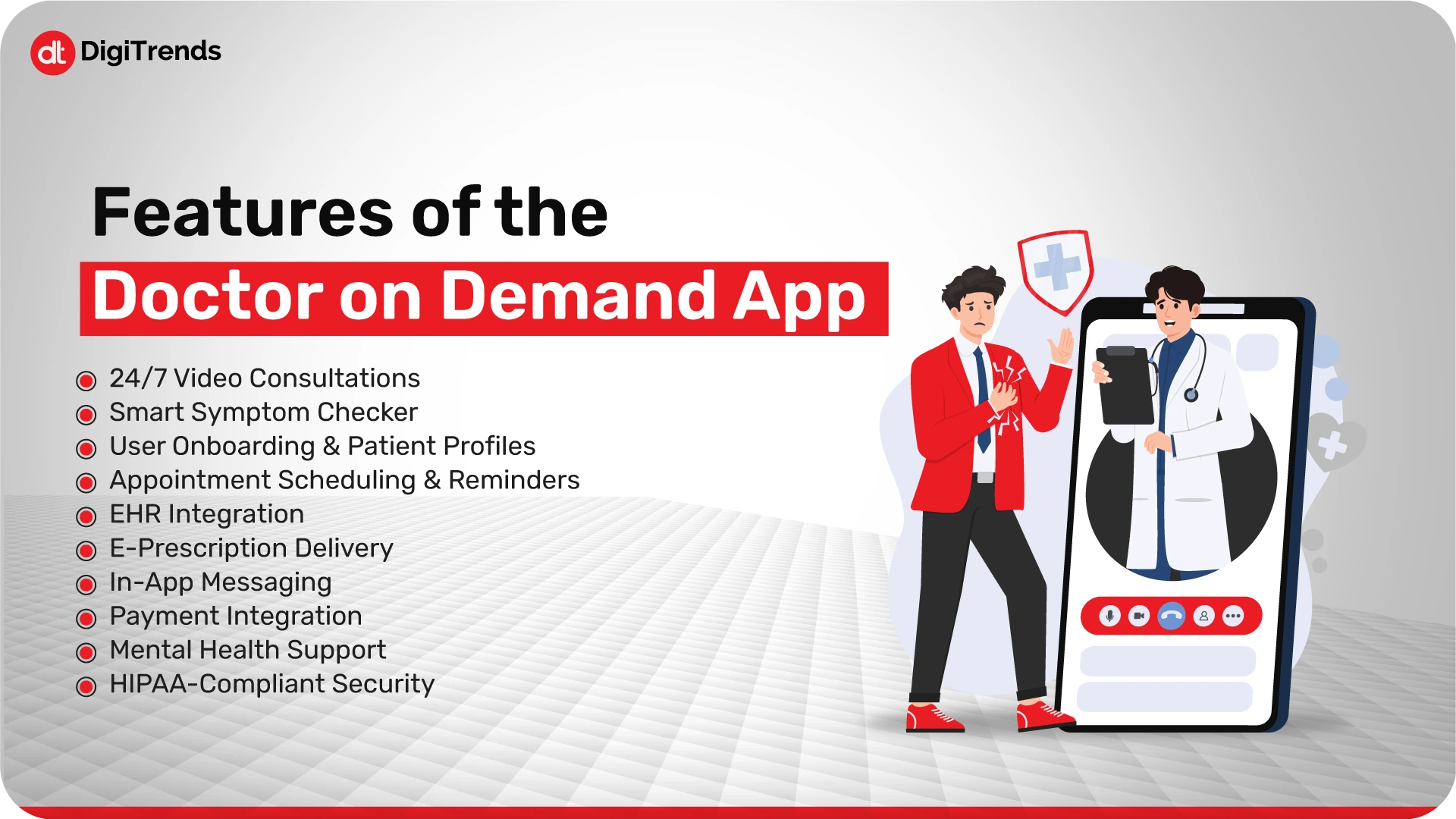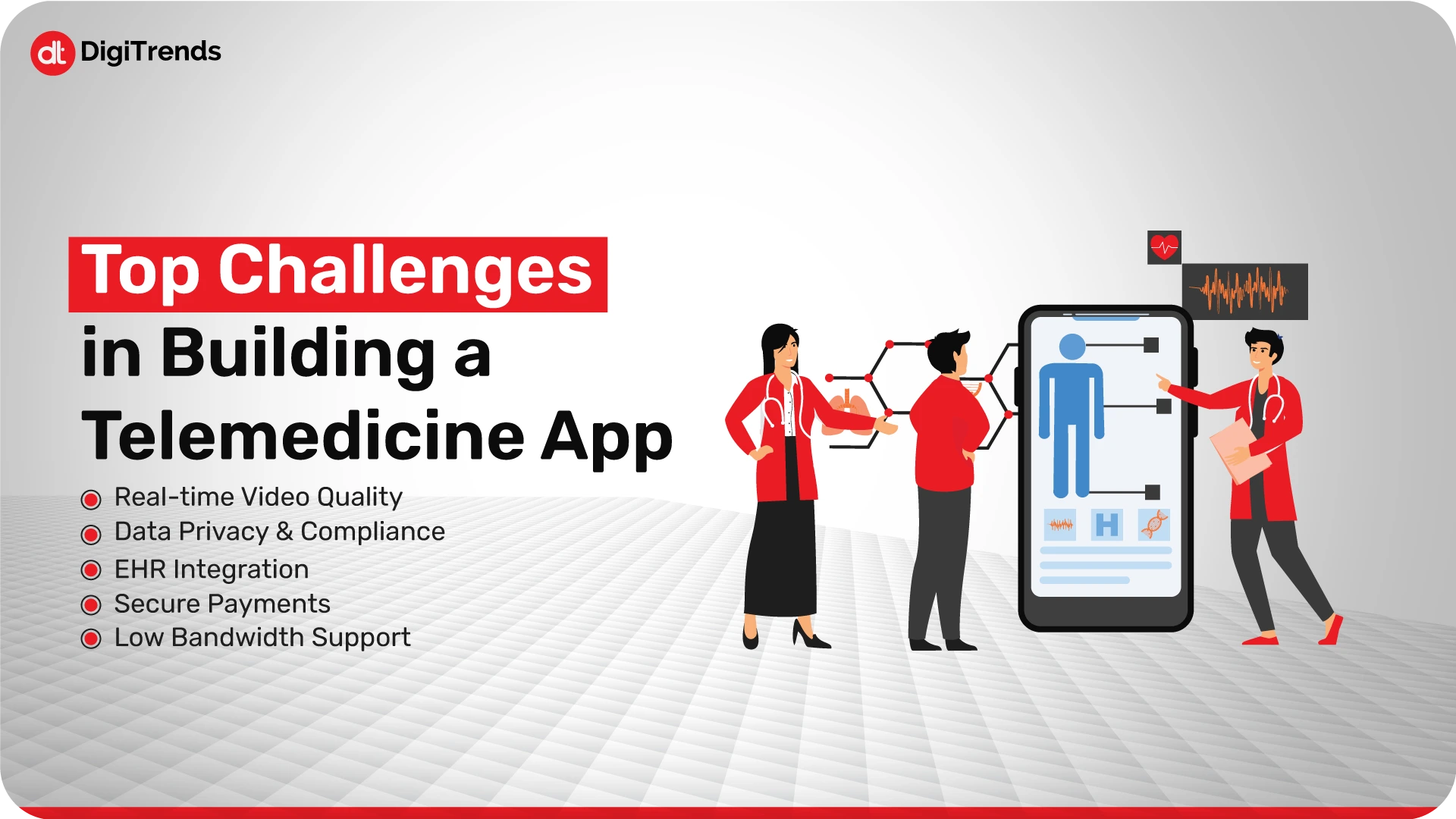
AI Reducing Healthcare Costs: Real Savings Backed by 7 Startup Case Studies
Look at the real numbers from healthcare organizations that show AI reducing healthcare costs in real. The AI lens makes costs look controllable.
Continue Reading
Want to know what the new normal looks like in 2025?
It’s connecting with a healthcare professional in under five minutes, all with just a few taps on your phone.
Platforms like Doctor On Demand have made this shift not only possible but expected. No more rushing to crowded hospitals for minor health concerns. Instead, a licensed doctor connects with you while you’re still in bed, on your couch, or even during a work break.
Let’s have a look at the features of the Doctor on Demand app and discuss what it takes to build a similar app.
So, what does a telemedicine solution really mean?
Telemedicine is an online health service that lets patients communicate with their doctor for consultation, prescription, appointment arrangement, record access, and sometimes mental health or chronic disease support. It provides a connection between patients and healthcare providers when choosing to see one another in person isn’t needed.
However, in 2025, functionality alone isn’t enough; design holds just as much weight. The most successful telemedicine apps don’t just work well; they feel modern, intuitive, and tailored to the user. People now expect healthcare apps to be as sleek and user-friendly as their favorite lifestyle or social platforms. A clean interface, smooth navigation, and personalized experiences can significantly boost user trust, engagement, and satisfaction. In an increasingly competitive market, great design isn’t a luxury—it’s a necessity that can make or break your app’s success.
Doctor On Demand is one of the leading telemedicine apps that provides access to medical services and high-quality care from licensed professionals through mobile phones. The app allows users to book virtual appointments with physicians, psychiatrists, and therapists, making it easy to address a wide range of health concerns from the comfort of home. After consultations, prescriptions can be sent directly to the user’s preferred pharmacy, ensuring a seamless experience. You can get help at any time, with only a little wait, if you have urgent matters, ongoing health problems, need preventive care, or want to see about your mental health. To further help people from all financial backgrounds, Doctor On Demand allows you to pay either with insurance or with set fees for each visit.
Since more people want easy access to healthcare, creating the Doctor On Demand app is important because it helps deliver healthcare where and when people require it. This app is different because it puts patients first, has a user-friendly layout, and runs smoothly, proving that the innovation behind doctor-on-demand app development has played a great part in transforming healthcare.
In 2025, choosing to build a telemedicine solution is smart business and a quick answer to how people are using healthcare today. With technology shaping the way people live each day, patients are hoping medical services can be reached easily, quickly, and from any location. Telemedicine provides this service and much more.
Here are the key reasons to invest in building a remote healthcare app:
A telemedicine app overcomes issues created by distance, difficulty moving, and restricted hours for doctors. People who face geographical or time barriers can now receive medical advice from their place of work or home. This creates a real impact for seniors, patients with ongoing health problems, and underserved communities, who often put off seeing a doctor.
The use of virtual care apps lowers expenses for patients as well as for healthcare providers. Working out of clinics means lower rent and personnel costs, and patients stay close to home, so they don’t lose work time or have to travel. Because medical services are more affordable, patients are inclined to get help sooner and more frequently.
Apps that remind patients, send messages, let them arrange visits, and see their documents help them get involved. If a treatment plan fits well into your life, you will often find it easier to follow. If patients find their healthcare appointments fast and simple, they are more likely to go back.
Unlike regular healthcare, virtual care apps are accessible at any time, day or night. If you feel anxious at night or get a fever during the weekend, a doctor is never far away. The flexibility allows clinics to respond quickly in an emergency and to take better care of patients with chronic illnesses.
Across the world, more people need digital healthcare. Telemedicine can offer profitable expansion for healthcare businesses and help them move forward with new trends. No matter if they use Artificial Intelligence for diagnostics or move into new fields, having a solid app enables healthcare businesses to develop and remain on top in the industry.

Improving a telehealth platform means including features that allow users to access it easily, increase care efficiency, and give them the best support. There are plenty of useful features on the Doctor on Demand app, showing that it can answer current demands for health services. They help to improve the service’s user experience and also support better growth. Let’s take a look at some main features of the Doctor on Demand app; every one of them needs to be considered when building a similar app.
These features collectively form the backbone of a reliable, user-friendly, and scalable telemedicine solution. Incorporating them effectively in telehealth platform development ensures the platform can deliver high-quality care while meeting the expectations of modern users.
You should begin by looking into the current state of the telehealth market. Look at current platforms, find what is missing in their service offerings, and learn what users expect. Understanding the market helps you decide which aspects of your healthcare app to develop, such as providing additional functions for previously neglected medical groups or making the app easier to use.
What main features should your app be able to provide? Typically, these apps have video consultations, enable people to book appointments, communicate within the app, handle prescriptions, and support online payment. Integrating with EHR systems is required to offer a stable form of patient care. Your chosen features must match both major industry trends and your main area of focus.
Following healthcare rules is necessary. It is a requirement under HIPAA for U.S. applications to protect patient privacy. Your data storage should be extra secure, communication with the back-end should be encrypted, and user logins should be verified before accessing the app. Having an experienced healthcare app development team like DigiTrends makes it likely that your platform is compliant with regulations.
An interface that is easy to use helps keep patients happy and the hospital working efficiently. The design must ensure that important actions, such as scheduling and connecting to virtual visits, are as straightforward as possible for everyone. When the site design is easy to navigate and neat, users keep coming back.
Your app must remain reliable under growing user demand. Develop a strong backend architecture and use cloud infrastructure to manage large data loads and user traffic. Scalability ensures your app can evolve without performance issues as your user base expands.
Develop a system that ensures all the healthcare professionals on your site meet the requirements. The process needs to check employment histories and requires the uploading of certificates. To win users’ trust and maintain the level of service, a clear and honest network of providers must be set up.
A launch will only succeed if it is well-marketed. Launch digital advertising, use social media, join with influencers, and distribute specific content to advertise your platform. Show both patients and providers what is special about the platform and why they should use it.
Post-launch, user feedback is your most valuable tool. Use reviews, surveys, and usage analytics to identify pain points and opportunities for improvement. Regular updates based on this feedback will keep your app competitive, responsive, and aligned with user expectations.
The cost of developing a digital healthcare app can vary significantly based on several key factors, including the complexity of features, development team rates, compliance requirements, and the overall scale of the project.
Let’s break down the cost of building a telehealth solution:
| Component | Estimated Cost (USD) | Description |
| UI/UX Design | $1,000 – $5,000 | Designing intuitive, user-friendly interfaces for patients and doctors. |
| Front-end & Back-end development | $20,000 – $50,000 | Core development work for mobile apps (iOS/Android) and backend infrastructure. |
| Third-party Integrations | $10,000 – $20,000 | Integration of APIs for video calling, payment gateways, maps, etc. |
| EHR & E-Prescription Integration | $5,000 – $10,000 | Connecting to electronic health records systems and enabling prescription flow. |
| Security & Compliance (HIPAA, etc.) | $8,000 – $15,000 | Ensuring patient data protection and regulatory compliance. |
| Quality Assurance & Testing | $5,000 – $15,000 | Detecting bugs and ensuring smooth app performance across devices. |
| Doctor Onboarding System | $5,000 – $10,000 | Features for verifying doctor credentials and managing profiles. |
| Maintenance | 12% – 15% of the initial development cost | Ongoing updates, server costs, and overall project coordination. |
The total cost of the Doctor on Demand app development is around $70,000 to $200,000. The cost of developing a telemedicine app similar to Doctor on Demand may vary due to different features and design.
If you’re looking to create a telemedicine solution, DigiTrends offers complete telehealth platform development services, from idea to execution. Whether you’re starting from scratch or improving an existing app, we can help bring your remote healthcare app vision to life.
Advancements in healthcare technology and rising demand for convenience are driving the rapid growth of the telemedicine industry. As patients seek faster and more flexible ways to access care, telehealth apps are becoming a crucial part of the healthcare sector.
According to Next Big Technology, the global telemedicine market is projected to reach $55.9 billion by 2025. This expansion reflects a shift in consumer behavior, where more people are turning to mobile and digital solutions for affordable and on-demand healthcare.
Currently, the telemedicine market has reached approximately $24.9 billion and continues to develop on a regular basis. Thanks to advanced technology, efficient user experiences, and effective healthcare app development, Doctor On Demand leads the industry. It’s obvious from its achievements that this area offers a lot of potential to people who focus on making secure, simple, and distinct platforms.
Anyone hoping to build a telemedicine solution should understand the competitive landscape and growth potential of the telemedicine market.

Creating a telemedicine solution like Doctor on Demand involves more than just adding useful features; it also involves tackling hard technical and regulatory issues to provide a good, protected, and convenient user environment. Some of the most important roadblocks encountered during Doctor On Demand app development are listed below:
Successfully overcoming these challenges is important to deliver a trustworthy and effective telemedicine solution. Prioritizing security, performance, and accessibility will ensure that both patients and healthcare providers can rely on your platform for safe, efficient, and high-quality virtual care.
Doctor on Demand is well known in telehealth, yet various other platforms provide similar or special services as well. If people require urgent care, mental health support, or routine primary care, these similar platforms offer solutions to suit everyone. Going through these services can help anyone looking into Doctor On Demand app development discover useful information about available features, business systems, and innovative ideas.
Digitalization is taking over all industries, people now think healthcare should be as easy as getting takeout or a ride through a mobile app, which is what the Doctor On Demand app is providing. But developing a similar healthcare app isn’t just about adding all kinds of features. It means knowing what patients want, making their experience easy and safe, and allowing doctors to give quality care remotely.
Ensuring the appropriate subject choice, data security, and smooth video communication is not easy. There are obstacles in the way, yet they make what we’re trying to achieve more valuable. If telemedicine apps perform well, they allow patients to trust doctors, make appointments quicker, and extend healthcare access to those who can’t easily access services.
If you wish to create a telehealth solution similar to a doctor-on-demand app, hiring a professional healthcare app development team is the right choice. Companies like DigiTrends have dedicated teams that specialize in building custom healthcare app solutions, making it easier for healthcare providers to meet their goals and stay ahead in the digital healthcare space.
Still doubtful about building a telemedicine app like Doctor On Demand?
With the healthcare industry rapidly embracing technology, this is your moment to lead and innovate.
The future of your healthcare business relies on the choices you make today!
